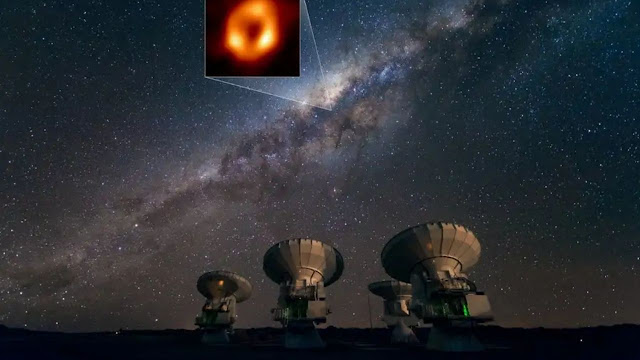Black holes are some of the most mysterious and fascinating
objects in the universe. They are regions of spacetime where gravity is so
strong that nothing, not even light, can escape. For decades, scientists have
dreamed of photographing a black hole, but the challenge has been daunting.
There were two main reasons why photographing a
black hole was such a gamble. First, astronomers weren't sure if their
telescopes would be powerful enough to see the black hole. Black holes are very
small and very faint, and even the most powerful telescopes on Earth can only
see objects that are much larger and brighter.
Second, astronomers weren't sure if the black
hole would be where they expected it to be. Black holes are constantly moving
and changing, and it's difficult to predict their exact location. If the
astronomers had been slightly off in their calculations, they might have missed
the black hole altogether.
Despite the risks, astronomers were determined
to photograph a black hole. They knew that such an image would revolutionize
our understanding of these mysterious objects and provide new insights into the
nature of gravity itself.
The astronomers who worked on the project
created a global network of radio telescopes called the Event Horizon Telescope
(EHT). The EHT linked together eight telescopes on four continents, creating a
virtual telescope the size of the Earth.
In April 2017, the EHT observed the M87 galaxy
for 10 days. The astronomers collected an enormous amount of data, which they
then spent years processing and analyzing.
In 2019, the astronomers finally released the
first image of a black hole. The image showed a bright ring of light
surrounding a dark center. The bright ring is caused by light bending and
swirling around the black hole's immense gravity. The dark center is the event
horizon, the point of no return beyond which nothing can escape.
The image of the M87 black hole was a
groundbreaking achievement. It was the first direct evidence that black holes
actually exist, and it provided new insights into the nature of these
mysterious objects. The image also confirmed some of the predictions of Albert
Einstein's theory of general relativity.
Why the gamble paid off
There were a few reasons why the gamble to
photograph a black hole paid off. First, the astronomers were able to use the
EHT to create a virtual telescope that was powerful enough to see the black
hole. Second, the black hole in the M87 galaxy is one of the largest and
brightest black holes known to science, which made it easier to see. Third, the
astronomers were able to use sophisticated image processing techniques to
combine the data from the eight telescopes and create a clear image of the
black hole.
The challenges of photographing a black hole
There were a number of challenges that the astronomers
had to overcome in order to photograph a black hole. One of the biggest
challenges was the fact that black holes are very small and very faint. The
black hole in the M87 galaxy, for example, is only about 40 billion kilometers
in diameter, which is about the same size as the orbit of Neptune.
Another challenge was the fact that black holes
are constantly moving and changing. This is because black holes are very
massive and they have a strong gravitational pull. The gravitational pull of a
black hole can warp spacetime and cause nearby objects to move erratically.
Finally, the astronomers had to overcome the
challenge of combining the data from the eight EHT telescopes. This was a very
complex task, and it required the astronomers to develop new image processing
techniques.
The future of black hole photography
The success of the EHT has paved the way for
future black hole photography. Astronomers are already planning to use the EHT
to image other black holes, including the black hole at the center of our own
Milky Way galaxy.
Astronomers are also working on developing new telescopes and technologies that will allow them to image black holes in more detail. For example, astronomers are developing a new telescope called the Next Generation Event Horizon Telescope (ngEHT). The ngEHT will be much more powerful than the EHT, and the ngEHT is expected to be able to image black holes with much higher resolution and to learn more about their properties and behavior.
Another exciting new development is the use of artificial
intelligence (AI) to process black hole images. AI can be used to remove noise
from images and to enhance features. This could lead to even clearer and more
detailed images of black holes in the future.
The future of black hole photography is very bright. With the development of new telescopes and new techniques, astronomers hope to learn more than ever before about these mysterious objects. Astronomers are confident that they will be able to image more black holes in the coming years, and that these images will revolutionize our understanding of these mysterious objects.
Conclusion
Photographing a black hole was a massive gamble, but it paid off handsomely. The image of the M87 black hole was a groundbreaking achievement that has revolutionized our understanding of these mysterious objects.

Comments
Post a Comment
any suggestion on my side